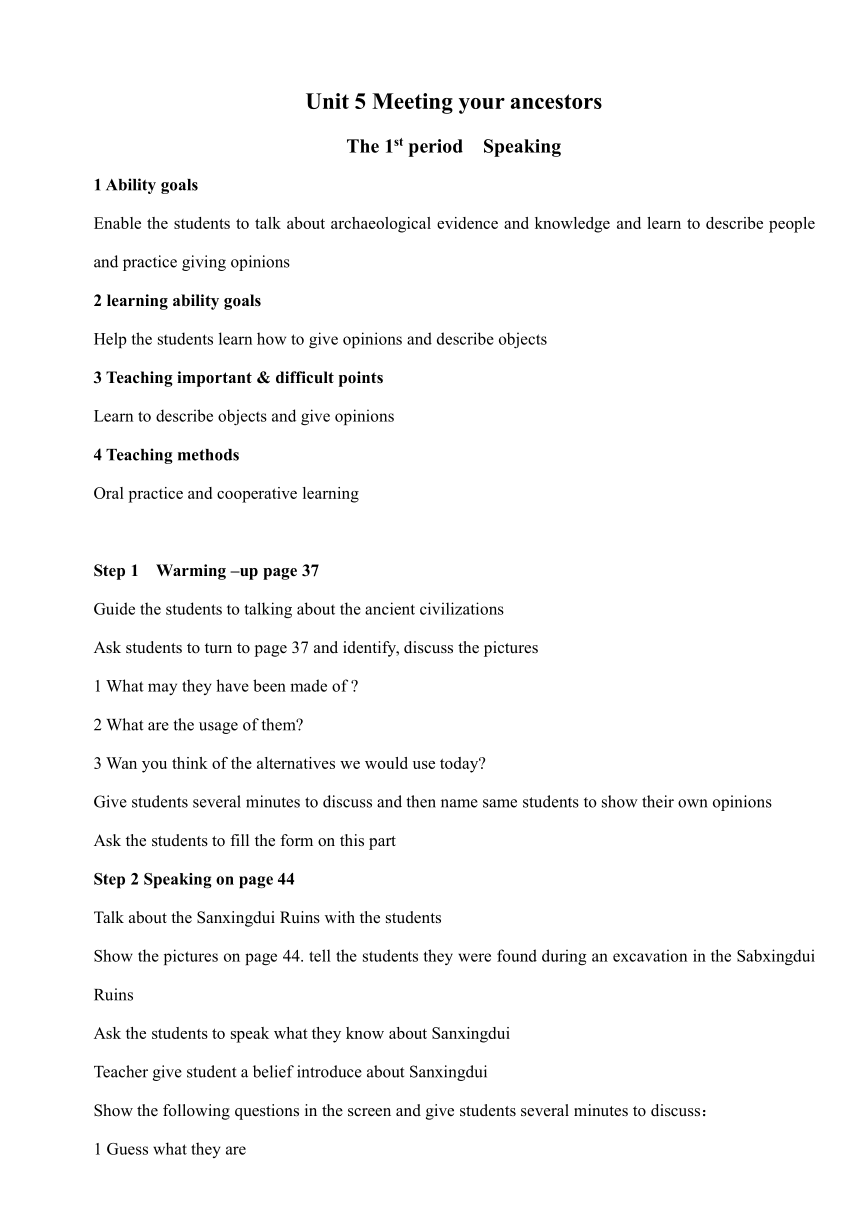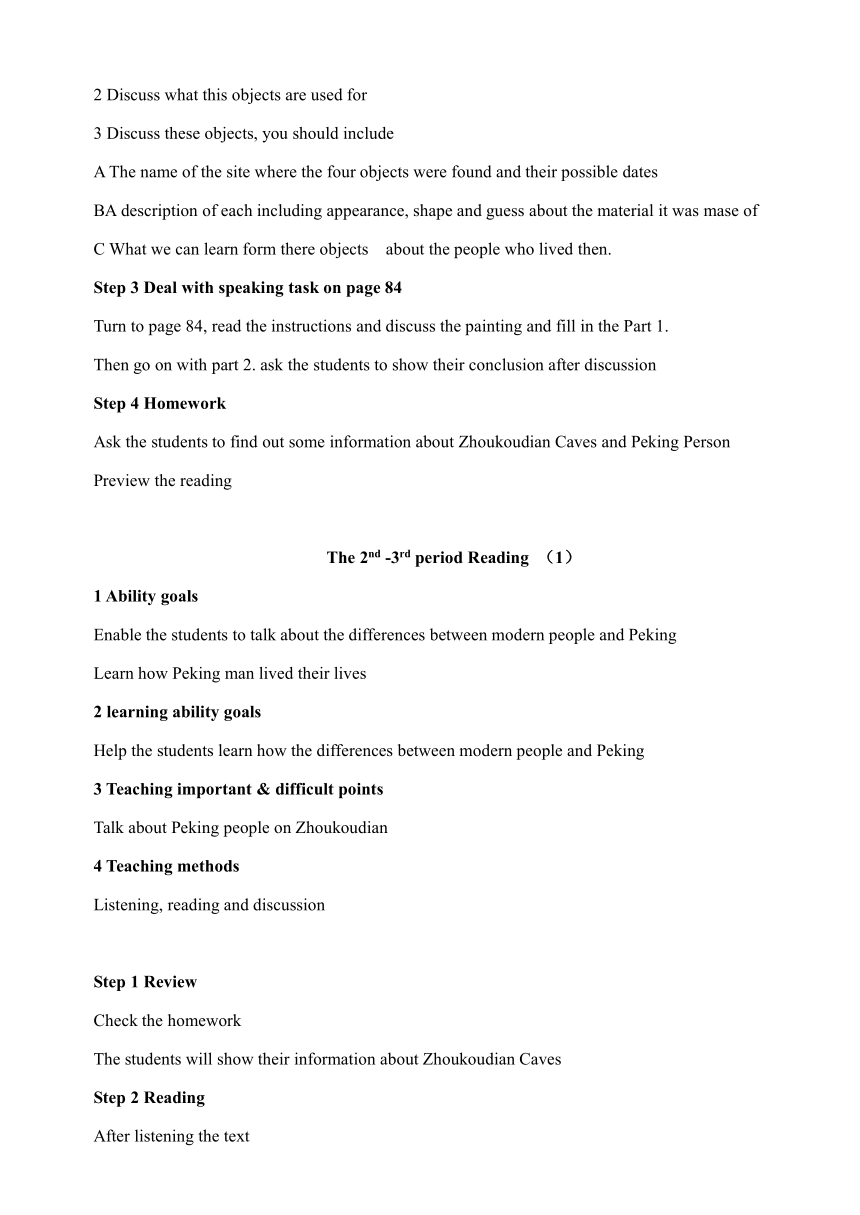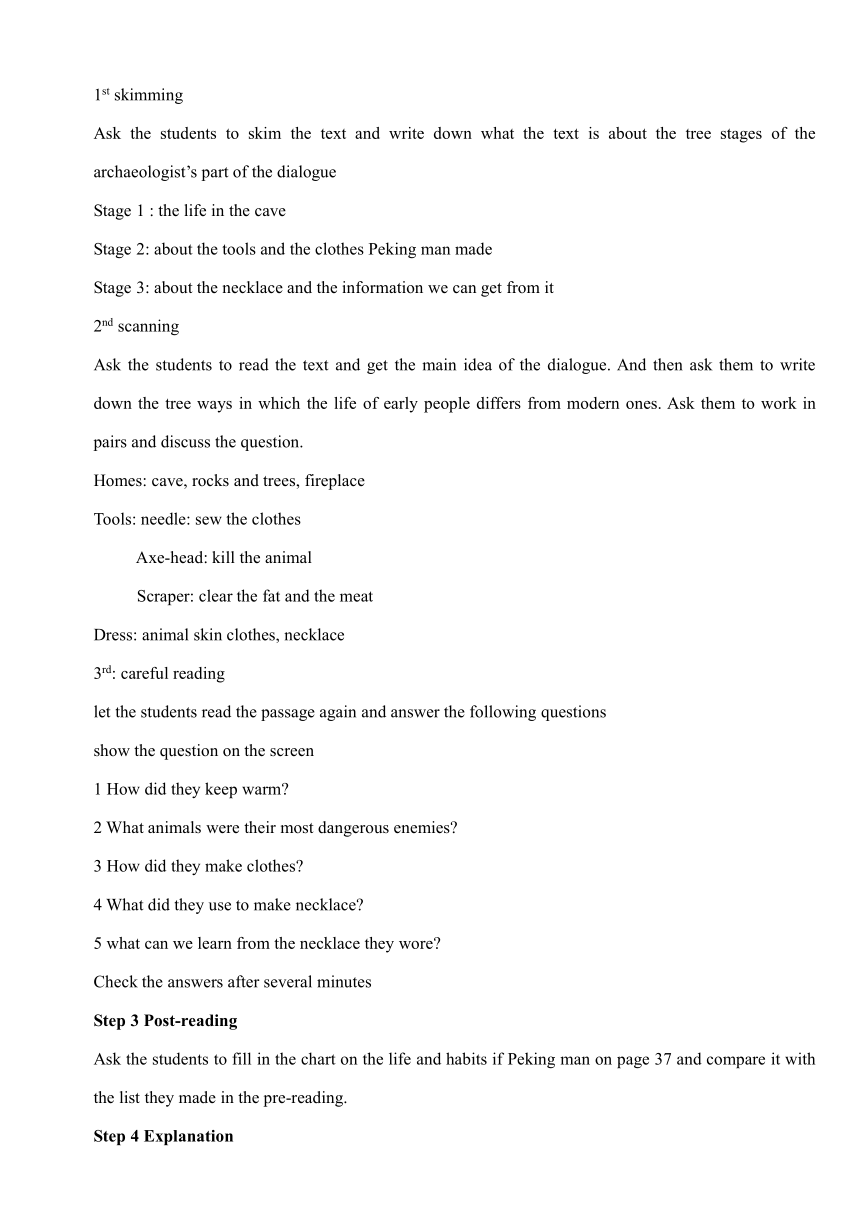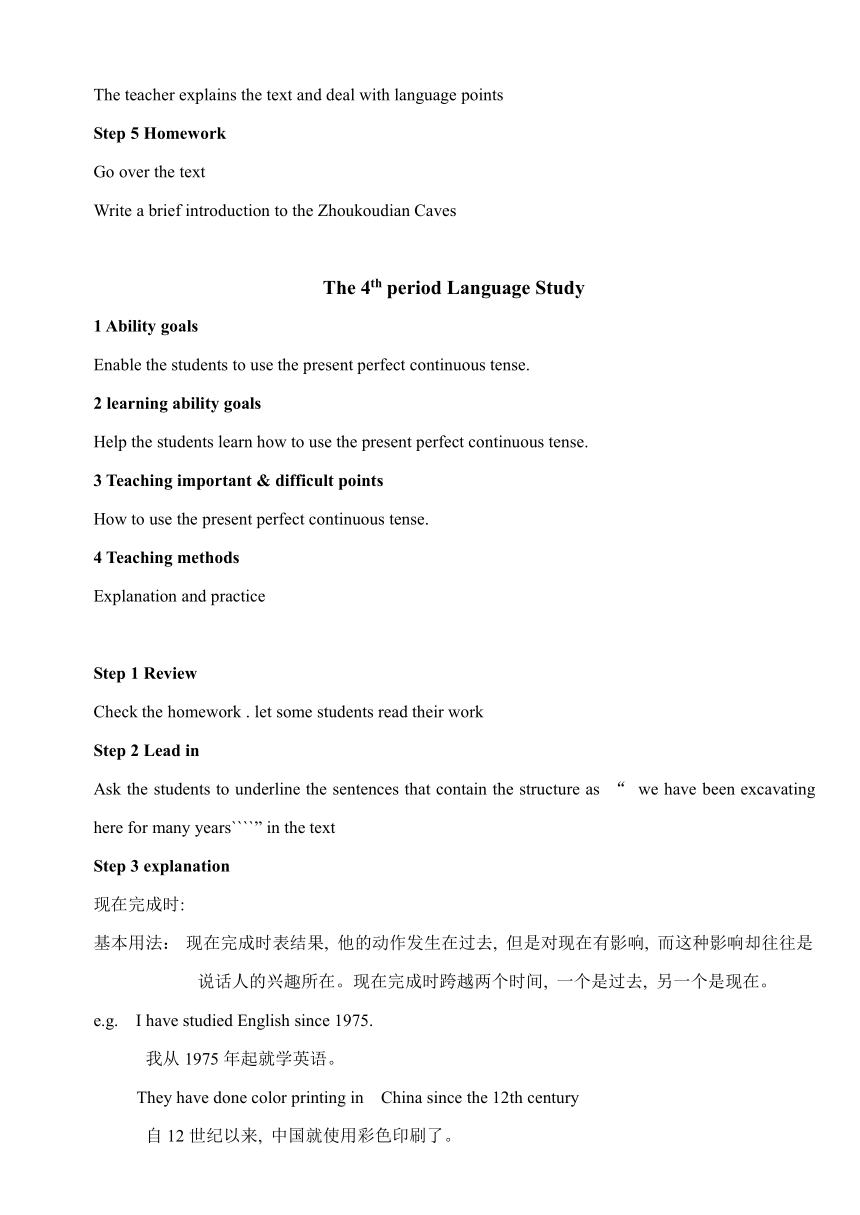book 8 Unit 5 Meeting your ancestors[下学期]
文档属性
| 名称 | book 8 Unit 5 Meeting your ancestors[下学期] |  | |
| 格式 | rar | ||
| 文件大小 | 14.1KB | ||
| 资源类型 | 教案 | ||
| 版本资源 | 人教版(新课程标准) | ||
| 科目 | 英语 | ||
| 更新时间 | 2009-07-16 06:55:00 | ||
图片预览




文档简介
Unit 5 Meeting your ancestors
The 1st period Speaking
1 Ability goals
Enable the students to talk about archaeological evidence and knowledge and learn to describe people and practice giving opinions
2 learning ability goals
Help the students learn how to give opinions and describe objects
3 Teaching important & difficult points
Learn to describe objects and give opinions
4 Teaching methods
Oral practice and cooperative learning
Step 1 Warming –up page 37
Guide the students to talking about the ancient civilizations
Ask students to turn to page 37 and identify, discuss the pictures
1 What may they have been made of
2 What are the usage of them
3 Wan you think of the alternatives we would use today
Give students several minutes to discuss and then name same students to show their own opinions
Ask the students to fill the form on this part
Step 2 Speaking on page 44
Talk about the Sanxingdui Ruins with the students
Show the pictures on page 44. tell the students they were found during an excavation in the Sabxingdui Ruins
Ask the students to speak what they know about Sanxingdui
Teacher give student a belief introduce about Sanxingdui
Show the following questions in the screen and give students several minutes to discuss:
1 Guess what they are
2 Discuss what this objects are used for
3 Discuss these objects, you should include
A The name of the site where the four objects were found and their possible dates
BA description of each including appearance, shape and guess about the material it was mase of
C What we can learn form there objects about the people who lived then.
Step 3 Deal with speaking task on page 84
Turn to page 84, read the instructions and discuss the painting and fill in the Part 1.
Then go on with part 2. ask the students to show their conclusion after discussion
Step 4 Homework
Ask the students to find out some information about Zhoukoudian Caves and Peking Person
Preview the reading
The 2nd -3rd period Reading (1)
1 Ability goals
Enable the students to talk about the differences between modern people and Peking
Learn how Peking man lived their lives
2 learning ability goals
Help the students learn how the differences between modern people and Peking
3 Teaching important & difficult points
Talk about Peking people on Zhoukoudian
4 Teaching methods
Listening, reading and discussion
Step 1 Review
Check the homework
The students will show their information about Zhoukoudian Caves
Step 2 Reading
After listening the text
1st skimming
Ask the students to skim the text and write down what the text is about the tree stages of the archaeologist’s part of the dialogue
Stage 1 : the life in the cave
Stage 2: about the tools and the clothes Peking man made
Stage 3: about the necklace and the information we can get from it
2nd scanning
Ask the students to read the text and get the main idea of the dialogue. And then ask them to write down the tree ways in which the life of early people differs from modern ones. Ask them to work in pairs and discuss the question.
Homes: cave, rocks and trees, fireplace
Tools: needle: sew the clothes
Axe-head: kill the animal
Scraper: clear the fat and the meat
Dress: animal skin clothes, necklace
3rd: careful reading
let the students read the passage again and answer the following questions
show the question on the screen
1 How did they keep warm
2 What animals were their most dangerous enemies
3 How did they make clothes
4 What did they use to make necklace
5 what can we learn from the necklace they wore
Check the answers after several minutes
Step 3 Post-reading
Ask the students to fill in the chart on the life and habits if Peking man on page 37 and compare it with the list they made in the pre-reading.
Step 4 Explanation
The teacher explains the text and deal with language points
Step 5 Homework
Go over the text
Write a brief introduction to the Zhoukoudian Caves
The 4th period Language Study
1 Ability goals
Enable the students to use the present perfect continuous tense.
2 learning ability goals
Help the students learn how to use the present perfect continuous tense.
3 Teaching important & difficult points
How to use the present perfect continuous tense.
4 Teaching methods
Explanation and practice
Step 1 Review
Check the homework . let some students read their work
Step 2 Lead in
Ask the students to underline the sentences that contain the structure as “ we have been excavating here for many years````” in the text
Step 3 explanation
现在完成时:
基本用法: 现在完成时表结果, 他的动作发生在过去, 但是对现在有影响, 而这种影响却往往是说话人的兴趣所在。现在完成时跨越两个时间, 一个是过去, 另一个是现在。
e.g. I have studied English since 1975.
我从1975年起就学英语。
They have done color printing in China since the 12th century
自12世纪以来, 中国就使用彩色印刷了。
Present Perfect Continuous : Has/ have + been +V+ing
现在完成进行时:
基本用法
1) 强调时间的持续性。如:
电话响了差不多一分钟, 为什么没人接
The telephone has been ringing for almost a minute. Why doesn’t someone answer it
2) 表重复。叙述从过去某时到现在或最近已在重复的动作。如:
最近天气变化无常, 我时常感冒。
The weather has been changeable lately; I’ve been having a lot of colds.
3) 有感彩。如:
今天真是一个多事之日。
Too much has been happening today.
现在完成进行时和现在完成时的比较:
A. 未完结性
我把窗户擦干净了。
I’ve cleaned the windows.
我擦窗户来着。(可能窗户尚未擦完)
I’ve been cleaning the windows.
B. 短暂性
现在完成时与现在完成进行时都可以表示延续至今的状态, 但完成进行是常表示短暂性。
A. They have lived in New York.
B. They have been living in New York.
C. 刚完结性
与现在完成时相比, 现在完成进行时有时可以表示刚刚完结的动作。有时它是现在事件的直接原因, 或者是得出结论的证据。如:
我的手很脏, 我在油汽车来着。
My hands are dirty. I’ve been painting the car.
你的眼睛又红又肿, 你是不是哭来着?
Your eyes are red and puffy. Have you been crying
D. 连续性或重复性
现在完成进行时常常用于表示延续至今的连续性或重复性动作。如:
Jim have been phoning Jenny every night for the several month
结论: 现在完成进行时主要用于表示
A. 过去开始而且现在仍在进行的动作。
B. 过去开始, 现在刚刚停止的动作。
C. 现在看到其直接结果的动作。
现在完成时主要用于表示已经完成的动作及其与现在的关系。
Step 4 Homework
Finish exercises 1,2 on page 80 and 2,3 on page 41
The 5th period Reading (2)
1 Ability goals
Enable the students to describe the life of early people
2 learning ability goals
Help the students learn how to describe the life of early people
3 Teaching important & difficult points
Enable the students to know more and describe the life of early people
4 Teaching methods
Listening, reading and discussion
Step 1 reading
check the homework before starting the new lesson
Play the tape for the students to listen. At the same tie, the students are asked to find the answer to the following questions
1. Which jobs did Dahu do
2. Which jobs did Lala do
3. Who works cooperatively and who does tasks alone
4. Who does the most dangerous tasks
5. Where does the danger come from
After listening to the tape, the students discuss the above questions in groups and then try to find the answers to the above questions
Step 2 post-reading
Ask the students to discuss what the possible work division was between men and women at that time
After a few minutes. Check the answers
Men’s tasks 1 Making and repairing tools
2. Fishing
3. Cutting down trees
4. Hunting animals
5. Protecting the group from harm
Women’s tasks 1. Collecting nuts, fruit and water
2. Cutting up meat and fish for cooking
3. Preparing skins to make clothes
4. Preparing food
5. Looking after children
Step 3 explanation
The teacher explains the text and deal with language points
Step 4 homework
Read the text
Preview the language point in the text
Practice using two or more adjectives to describe the SanxinduiRuins objects on page 44
The 6th period Reading (3)
1 Ability goals
Enable the students to comprehend the reading text on Work Book
2 learning ability goals
Help the students learn how to comprehend the reading text on Work Book
3 Teaching important & difficult points
learn and solve two archaeological problems
4 Teaching methods
Listening, reading and discussion
Step 1 reading
Play the tape for the students to listen. At the same tie, the students are asked to find the answer to the following questions
1. How did they know whose tomb it was
They read his name on a black box.
2. Why do you think they thought these things came from another civilization
Because they were so strange and wonderful---more wonderful than anyone could imagine.
3. Why did Carter get excited when he noticed the door to the tomb was still fastened
Because it meant that the tomb had not been opened by thieves.
Step 2 post-reading
Ask the students to discuss and finish the exercise 2 and the exercise 3 on page 83
Suggested answers to Exercise 3
1. I would have to lock the tomb securely so that thieves could not steal the finds.
2. I would have to lock the tomb securely so that the sunlight and temperature would not affect the finds in the tomb. Otherwise the finds may be spoiled.
3. I would have to lock the tomb securely so that I could record all the finds carefully, and I would not want any of the finds to be moved
Step 3 explanation
The teacher explains the text and deal with language points
Step 4 homework
Read the text
Finish exercise 1 and 2 on page 4o and page 79
The 7th period Writing and English Weekly
1 Ability goals
Enable the students to write a short article
Enable the students to finish the exam in English Weekly
2 learning ability goals
Help the students the students to write a short article
Help the students to finish the exam in English Weekly
3 Teaching important & difficult points
the technique of writing article
4 Teaching methods
writing and practice explanation
step 1 writing on page 85
1 turn to page 85 and look at the pictures and the questions below them. Discuss the questions
2 several minutes later, check the discussions
3 ask the students t write two paragraphs giving their own ideas as the information tells them to do
4 ask the students to read out their articles
step 2 English weekly
1 give students about 1o minutes to finish the Exercise of grammar
2 explain the grammar for them
Step 3 Homework
Ask the students to summarize what they have learned in this unit
The 1st period Speaking
1 Ability goals
Enable the students to talk about archaeological evidence and knowledge and learn to describe people and practice giving opinions
2 learning ability goals
Help the students learn how to give opinions and describe objects
3 Teaching important & difficult points
Learn to describe objects and give opinions
4 Teaching methods
Oral practice and cooperative learning
Step 1 Warming –up page 37
Guide the students to talking about the ancient civilizations
Ask students to turn to page 37 and identify, discuss the pictures
1 What may they have been made of
2 What are the usage of them
3 Wan you think of the alternatives we would use today
Give students several minutes to discuss and then name same students to show their own opinions
Ask the students to fill the form on this part
Step 2 Speaking on page 44
Talk about the Sanxingdui Ruins with the students
Show the pictures on page 44. tell the students they were found during an excavation in the Sabxingdui Ruins
Ask the students to speak what they know about Sanxingdui
Teacher give student a belief introduce about Sanxingdui
Show the following questions in the screen and give students several minutes to discuss:
1 Guess what they are
2 Discuss what this objects are used for
3 Discuss these objects, you should include
A The name of the site where the four objects were found and their possible dates
BA description of each including appearance, shape and guess about the material it was mase of
C What we can learn form there objects about the people who lived then.
Step 3 Deal with speaking task on page 84
Turn to page 84, read the instructions and discuss the painting and fill in the Part 1.
Then go on with part 2. ask the students to show their conclusion after discussion
Step 4 Homework
Ask the students to find out some information about Zhoukoudian Caves and Peking Person
Preview the reading
The 2nd -3rd period Reading (1)
1 Ability goals
Enable the students to talk about the differences between modern people and Peking
Learn how Peking man lived their lives
2 learning ability goals
Help the students learn how the differences between modern people and Peking
3 Teaching important & difficult points
Talk about Peking people on Zhoukoudian
4 Teaching methods
Listening, reading and discussion
Step 1 Review
Check the homework
The students will show their information about Zhoukoudian Caves
Step 2 Reading
After listening the text
1st skimming
Ask the students to skim the text and write down what the text is about the tree stages of the archaeologist’s part of the dialogue
Stage 1 : the life in the cave
Stage 2: about the tools and the clothes Peking man made
Stage 3: about the necklace and the information we can get from it
2nd scanning
Ask the students to read the text and get the main idea of the dialogue. And then ask them to write down the tree ways in which the life of early people differs from modern ones. Ask them to work in pairs and discuss the question.
Homes: cave, rocks and trees, fireplace
Tools: needle: sew the clothes
Axe-head: kill the animal
Scraper: clear the fat and the meat
Dress: animal skin clothes, necklace
3rd: careful reading
let the students read the passage again and answer the following questions
show the question on the screen
1 How did they keep warm
2 What animals were their most dangerous enemies
3 How did they make clothes
4 What did they use to make necklace
5 what can we learn from the necklace they wore
Check the answers after several minutes
Step 3 Post-reading
Ask the students to fill in the chart on the life and habits if Peking man on page 37 and compare it with the list they made in the pre-reading.
Step 4 Explanation
The teacher explains the text and deal with language points
Step 5 Homework
Go over the text
Write a brief introduction to the Zhoukoudian Caves
The 4th period Language Study
1 Ability goals
Enable the students to use the present perfect continuous tense.
2 learning ability goals
Help the students learn how to use the present perfect continuous tense.
3 Teaching important & difficult points
How to use the present perfect continuous tense.
4 Teaching methods
Explanation and practice
Step 1 Review
Check the homework . let some students read their work
Step 2 Lead in
Ask the students to underline the sentences that contain the structure as “ we have been excavating here for many years````” in the text
Step 3 explanation
现在完成时:
基本用法: 现在完成时表结果, 他的动作发生在过去, 但是对现在有影响, 而这种影响却往往是说话人的兴趣所在。现在完成时跨越两个时间, 一个是过去, 另一个是现在。
e.g. I have studied English since 1975.
我从1975年起就学英语。
They have done color printing in China since the 12th century
自12世纪以来, 中国就使用彩色印刷了。
Present Perfect Continuous : Has/ have + been +V+ing
现在完成进行时:
基本用法
1) 强调时间的持续性。如:
电话响了差不多一分钟, 为什么没人接
The telephone has been ringing for almost a minute. Why doesn’t someone answer it
2) 表重复。叙述从过去某时到现在或最近已在重复的动作。如:
最近天气变化无常, 我时常感冒。
The weather has been changeable lately; I’ve been having a lot of colds.
3) 有感彩。如:
今天真是一个多事之日。
Too much has been happening today.
现在完成进行时和现在完成时的比较:
A. 未完结性
我把窗户擦干净了。
I’ve cleaned the windows.
我擦窗户来着。(可能窗户尚未擦完)
I’ve been cleaning the windows.
B. 短暂性
现在完成时与现在完成进行时都可以表示延续至今的状态, 但完成进行是常表示短暂性。
A. They have lived in New York.
B. They have been living in New York.
C. 刚完结性
与现在完成时相比, 现在完成进行时有时可以表示刚刚完结的动作。有时它是现在事件的直接原因, 或者是得出结论的证据。如:
我的手很脏, 我在油汽车来着。
My hands are dirty. I’ve been painting the car.
你的眼睛又红又肿, 你是不是哭来着?
Your eyes are red and puffy. Have you been crying
D. 连续性或重复性
现在完成进行时常常用于表示延续至今的连续性或重复性动作。如:
Jim have been phoning Jenny every night for the several month
结论: 现在完成进行时主要用于表示
A. 过去开始而且现在仍在进行的动作。
B. 过去开始, 现在刚刚停止的动作。
C. 现在看到其直接结果的动作。
现在完成时主要用于表示已经完成的动作及其与现在的关系。
Step 4 Homework
Finish exercises 1,2 on page 80 and 2,3 on page 41
The 5th period Reading (2)
1 Ability goals
Enable the students to describe the life of early people
2 learning ability goals
Help the students learn how to describe the life of early people
3 Teaching important & difficult points
Enable the students to know more and describe the life of early people
4 Teaching methods
Listening, reading and discussion
Step 1 reading
check the homework before starting the new lesson
Play the tape for the students to listen. At the same tie, the students are asked to find the answer to the following questions
1. Which jobs did Dahu do
2. Which jobs did Lala do
3. Who works cooperatively and who does tasks alone
4. Who does the most dangerous tasks
5. Where does the danger come from
After listening to the tape, the students discuss the above questions in groups and then try to find the answers to the above questions
Step 2 post-reading
Ask the students to discuss what the possible work division was between men and women at that time
After a few minutes. Check the answers
Men’s tasks 1 Making and repairing tools
2. Fishing
3. Cutting down trees
4. Hunting animals
5. Protecting the group from harm
Women’s tasks 1. Collecting nuts, fruit and water
2. Cutting up meat and fish for cooking
3. Preparing skins to make clothes
4. Preparing food
5. Looking after children
Step 3 explanation
The teacher explains the text and deal with language points
Step 4 homework
Read the text
Preview the language point in the text
Practice using two or more adjectives to describe the SanxinduiRuins objects on page 44
The 6th period Reading (3)
1 Ability goals
Enable the students to comprehend the reading text on Work Book
2 learning ability goals
Help the students learn how to comprehend the reading text on Work Book
3 Teaching important & difficult points
learn and solve two archaeological problems
4 Teaching methods
Listening, reading and discussion
Step 1 reading
Play the tape for the students to listen. At the same tie, the students are asked to find the answer to the following questions
1. How did they know whose tomb it was
They read his name on a black box.
2. Why do you think they thought these things came from another civilization
Because they were so strange and wonderful---more wonderful than anyone could imagine.
3. Why did Carter get excited when he noticed the door to the tomb was still fastened
Because it meant that the tomb had not been opened by thieves.
Step 2 post-reading
Ask the students to discuss and finish the exercise 2 and the exercise 3 on page 83
Suggested answers to Exercise 3
1. I would have to lock the tomb securely so that thieves could not steal the finds.
2. I would have to lock the tomb securely so that the sunlight and temperature would not affect the finds in the tomb. Otherwise the finds may be spoiled.
3. I would have to lock the tomb securely so that I could record all the finds carefully, and I would not want any of the finds to be moved
Step 3 explanation
The teacher explains the text and deal with language points
Step 4 homework
Read the text
Finish exercise 1 and 2 on page 4o and page 79
The 7th period Writing and English Weekly
1 Ability goals
Enable the students to write a short article
Enable the students to finish the exam in English Weekly
2 learning ability goals
Help the students the students to write a short article
Help the students to finish the exam in English Weekly
3 Teaching important & difficult points
the technique of writing article
4 Teaching methods
writing and practice explanation
step 1 writing on page 85
1 turn to page 85 and look at the pictures and the questions below them. Discuss the questions
2 several minutes later, check the discussions
3 ask the students t write two paragraphs giving their own ideas as the information tells them to do
4 ask the students to read out their articles
step 2 English weekly
1 give students about 1o minutes to finish the Exercise of grammar
2 explain the grammar for them
Step 3 Homework
Ask the students to summarize what they have learned in this unit
